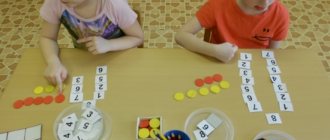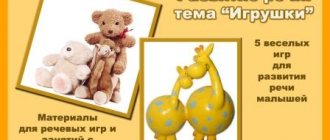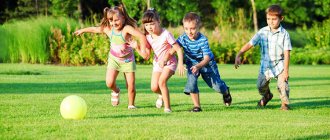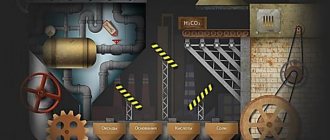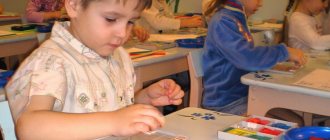For the development of a harmonious personality, mathematics classes for children will be very useful, which can be started from 3-4 years old - it is at this age that children begin to develop their first mathematical concepts. Do not forget that preschoolers should be taught through play, using dolls, pictures, unusual methods and techniques to maintain interest - this is the only way the effect will be maximum, knowledge will be stored in the head for a long time, and the child will not lose interest in the process.
Tips for parents
To make math classes not only useful, but also interesting and fun, you should adhere to the following recommendations:
- Act according to the principle “from simple to complex”: first offer the child those tasks that he can cope with, do not rush, work through the material in detail and do not take on new things while there are gaps in the old. You should not compare your child with other children, because everyone’s development follows an individual path, and what is understandable to one child may be very difficult for another. This is important to consider.
- Parental praise is a powerful motivation and should always be used, even if the successes are not impressive. You can at least praise your efforts.
- Of the two options - to hammer useful material into the child’s head at any cost or to instill in him curiosity and a desire to learn - without a doubt, you need to choose the second. Over time, the child will remember numbers, quantities, and learn to navigate in space, but if he loses interest in the process, then it will not be easy to regain it.
- Correct choice of task. The secret of success is to give the child a moment of small discovery, so tasks need to be selected so that he can cope. Success will help you gain and strengthen self-confidence.
You shouldn't push your baby. If he uses his fingers when learning to count, it’s okay. Very often, those children who have already learned to count orally test themselves in this way. Over time, they will gain self-confidence and will not use their fingers.
About counting on fingers
At the first stage of learning to count on fingers, you need to firmly grasp all possible combinations. The child should not think about the answer within one hand.
Card index of walks in the middle group for the winter
Attentiveness and memory develop, including tactile memory, because counting takes place in the head. You have to hold several data in memory at the same time. A quick solution depends on intelligence and speed of perception.
Child counts on fingers
Before learning to count on fingers, the child is already familiar with the concepts of “more,” “less,” and “also.” Can count objects in order within five.
Further:
- You need to start with 1+1=2. Children put two fingers together and get 2.
- Then add another finger = 3.
- Add one more to three and get the fourth result (four).
- Add one more finger to four and get five.
Now you can master subtraction:
- Subtract one finger from five and it becomes four.
- Subtract one finger from four and it becomes three.
- If you take away one finger from three, there will be two left.
- Subtract one finger from two and one remains.
The lesson should not exceed 20 minutes. Children get tired quickly. You can diversify the lesson by changing activities - warming up, singing something, solving riddles, and so on.
Important! You can't force it. It is always easier to “lure” someone somewhere than to force them. Elements of play, competition and reward will do more and better than anything else.
Tasks and exercises by age
The simplest options for preschoolers 3–4 years old are games with fingers.
- Using your fingers, show the same number in different ways (for example, 5 is 4 and 1, 2 and 3, 5 and 0).
- It is necessary to bend several fingers, the child’s task is to name the exact number.
In addition to fingers, you can use other counting materials - buttons, sticks, pencils, shells - anything that is interesting to the baby.
Exercises at home
There are many interesting games that you can play at home with kids 3-4 years old. For example, circle a number. The mother prepares the material in advance - on a piece of paper she writes numbers familiar to the child in a chaotic order, then asks him to find all the twos and circle them. The task can be made more difficult by suggesting that you circle the twos in blue, the threes in green, and the ones in red.
Mathematics is not only counting, but also logic, so you can play the game “Make a bouquet” with your child. To do this, draw a blank: simple pots, from which three stems are visible. You also need to prepare a set of buttons in three colors in advance. Next, mom gives the task - to select “flowers” for each pot so that one of them must be blue or so that there are blue and red flowers next to each other in each pot. The task is also good because it trains fine motor skills.
You can come up with games yourself using available materials. For example, invite your child to make a caterpillar out of multi-colored buttons, using 3 red, 4 blue, 1 green buttons. So that the baby does not forget the combinations, you need to draw a square, paint it with the appropriate color, and write a number next to it. Using colored rectangles, you can make a train with carriages in the same way.
Many children love to draw and color; this can also be used during classes by offering kids coloring books with numbers (you can draw them yourself or use ready-made options). The essence of such drawings is simple: the child is given a picture that he needs to color in different colors. The image is divided into blocks marked with numbers, each of which has its own color.
At 3–4 years old, children need to be introduced to geometric shapes. The following tasks are suitable for this:
- The parent draws a series of shapes (circle - square - triangle - rectangle), then asks the child to show, for example, a circle.
- Further, the task becomes more complicated - you need to color the circle red, the square green, the triangle blue, and leave the rectangle white.
To prevent your child from getting bored, you can come up with a fairy tale about the magical world of figures who are in trouble. Only completing tasks correctly will help save them.
Outdoor games
Don’t think that math classes with a preschooler are something boring. If you get creative, you can have some fun. So, there are several fun and useful games:
- "One to four." The mother hums a song and then says a number from 1 to 4. As soon as it sounds, the child must take a certain position, touching the floor with the number of points indicated by the named number (for example, if it is 1, then you need to stand on one leg, if 2 - just stay standing on two legs, 3 – lean on your hand and both legs, 4 – on your arms and legs at the same time).
- "Meow-woof." The mother gives the instruction: the child must jump forward as many times as she says “meow”, and back as many times as she says “woof”. To perform this, the baby first counts his mother’s phrases, and then his own jumps.
You can do math with your little one on the street, asking him to count all the cats he meets on the way, or find the number 3 everywhere, or show him objects that are shaped like a circle. You can also ask your child to compare which car is bigger, what is next - a shop or a store, and give similar tasks.
Obtaining mathematical skills can and should be organized in a playful way. Only in this case will the child have fun and unnoticed remember the necessary material.
Didactic games in mathematics for children 4 years of age (Games No. 1-6)
The article Using didactic games in mathematics in the work of a kindergarten teacher is here.
Program content: to form an understanding of the concepts of “many” and “one”, the ability to isolate a single object from a set, to form a set from single objects; introduce the words “many”, “one”, concentrate on the number of objects in the environment.
1. Magic bag
Aids: small plastic dolls (according to the number of players), a truck with a rope attached to make it convenient to transport, a bag.
Progress of the game. The teacher shows the children small dolls and asks what kind of toys they are on the table.
Children. Little dolls.
Educator. I have a lot of dolls on my table. (Calls 2-3 children, invites them to stroke the dolls, see how many there are. Then shows the children a bag and explains that they will now play with this magic bag. The called child hides the dolls in the magic bag).
Educator. Now, children, you will receive one doll from the bag. But the magic bag opens only to those who behave well. Come, Olya, put your hand in the bag and take out one doll. How many dolls have you received, Olya? Show all the children.
Olya. One doll.
Educator. Ira, how many dolls did Olya receive?
Ira. One.
The teacher calls 2-3 children and asks them to complete the same task.
At the same time, he activates other children, invites them to observe the actions of the called children and name how many dolls they will take out of the bag. At the same time, he makes sure that the children do not make mistakes.
Vova pulled out several dolls from the bag. The teacher helped him separate one doll, and the child put the rest back into the bag. Children with dolls go to their places.
Educator. You children behaved well, so now the bag will open for everyone. (With these words, he goes around all the children so that the other children also take one doll for themselves). You all have one doll, show them. Now we will take the dolls for a ride in the car. Whoever the car pulls up to will put his doll in the car. (He slowly drives the car past the children, and they take turns putting their dolls in it.) Vitya, how many dolls did you put in the car?
Vitya. One.
Teacher (asks 1-2 more children, and then addresses everyone). Look, children, how many dolls are in the car now?
Children. A lot of.
At the end of the game, the teacher invites the child to take all the dolls by car to the toy corner.
2. Game with flags
Aids: flags (according to the number of players).
Progress of the game. The teacher shows the children flags: “Look, children, how many flags I have (gives 1-2 children to hold them). There are so many flags that they don’t fit in Olya’s hands.”
Teacher (takes one flag). I'll take one checkbox. How many flags did I take?
Children. One.
Educator. Now each of you will take one flag. Natasha, take one flag. And you, Igor, take one flag.
Misha wants to take two flags. The teacher corrects him: “Take one flag, this is one flag.”
Children walk around the room with flags, wave them, and sing a song about the flag.
The teacher calls the children to him: “Now you yourself will put the flags in the vase. Sasha, how many flags have you checked?”
Sasha. One.
Educator. And you, Igor, how many flags did you check?
Games One.
Educator. Everyone put up one flag and there were a lot of them again. How many flags are there?
Children. A lot of.
3. Play with the pyramid
Benefits: identical pyramids (one for each player).
Progress of the game. The teacher shows the pyramid and invites the child to play with it; places a pyramid in front of himself and the child. Then he removes all the rings from his pyramid, takes them with his hands, and says that there are many of them. The teacher invites the child to remove the rings from his pyramid and play with them, saying that he also has a lot of them. Next, the teacher finds the largest ring in himself, shows it to the child and puts it on the rod of his pyramid, saying: “I put on one ring.” Helps the child find the same ring and says: “And you put on one ring.” Then the teacher finds himself a slightly smaller ring and, putting it on, again says: “I put on another ring.” The teacher invites the child to find the same ring in his home and put it on the rod.
The teacher accompanies the child’s actions with the words: “How many rings did Vitya put on?” “And Vitya put on another ring,” says the teacher if the child is silent. When the toy is composed, the teacher Fr.
4. Save the bunnies from the fox
Benefits: silhouettes of bunnies cut out of paper (one for each child), a toy fox.
Progress of the game. The teacher shows the children bunnies (all silhouettes are installed on a tray): “Look how many bunnies have gathered. Is it really a lot?"
Children. A lot of!
Educator. Now each of you will take one bunny. Igor will come over first. How many bunnies did you take? (One). And now Katya. Vasya, how many bunnies did Katya take? (One). And Lisa will take the same number of bunnies as Katya took. How many bunnies did you take, Lisa? (One). Now I'll go to each one. You, too, take one bunny each. Let all the bunnies jump in the clearing.
Children squat down, place bunnies at their feet and make movements as if bunnies are jumping.
Educator. How many bunnies are jumping in the clearing?
Children. A lot of.
Teacher (places a toy fox near a flower pot). Look here. Who is that sitting under the bush?
Children. Chanterelle.
Educator. How many chanterelles?
Children. One.
Teacher (puts the fox near the bunnies). Look, the fox is sneaking up on the bunnies, she wants to eat them. Save the bunnies from the fox (makes a movement as if the fox is rushing at the hares. Children run to their chairs).
Educator. Saved the bunnies from the fox? You see, fox, you are alone, but there are many of us. We won't let you see the bunnies.
5. Chickens and rooster
Benefits: paper hats for “chickens” and “rooster”. The “chicken coop” is fenced off with chairs.
Progress of the game. The teacher put on the children hats representing the head of a chicken, and on one child a hat representing the head of a cockerel.
Educator. You are all chickens, and Kolya is a rooster. There are many chickens, but only one cockerel. Cockerel, go to the “chicken coop” and call the chickens.
The cockerel goes behind the fence from the chairs and calls the hens “Ko-ko-ko!” The children go behind the fence.
Educator. How many chickens are there in the chicken coop?
Children. A lot of.
Educator. How many cockerels?
Children. One.
Teacher (goes aside and calls the chickens). Chick-chick-chick! Eat grains. Cockerel, call the hens, this is where I poured the grains.
The cockerel is calling the hens. The children come up and pretend to peck at the grains. At the end of the game, the cockerel takes the hens for a walk.
Educator. It's already late. Cockerel, take the hens to bed!
The children go behind the fence.
Educator: What a big chicken coop. There are a lot of chickens, but they are all housed. Are there really a lot of chickens?
Children. A lot of.
Educator. Are there a lot of cockerels too?
Children. There is only one cockerel.
6. Guess where there are many and where there is one
You will need: two buckets of different colors, small items (one in the red bucket, many in the green), two napkins, a screen.
Progress of the game. Educator. Children, do you know what's in these buckets? No? Volodya, come here, tip over this bucket, let the children see what was in it.
The children see that one chestnut has fallen out of the bucket.
The child called further shows that there were many chestnuts in the second bucket.
Educator. What color bucket was there one chestnut in? (In red). Which bucket contained a lot of chestnuts? (In green).
After this, the teacher, using a screen so that the children do not see, pours many chestnuts into a red bucket, and one into a green one. Cover the buckets with napkins.
Educator. Children, do you remember which bucket contained one chestnut?
Children. In red.
Educator. Go, Tanya, show me.
Tanya (approached). Here in this red one.
Educator. Dump the bucket and show how many chestnuts are in it now.
The children see that there are now a lot of chestnuts in the red bucket. And then they make sure that there is only one in the green bucket.
Toys can be replaced, baskets can be given instead of buckets, and other children can be invited.
MAGAZINE Preschooler.RF
Mathematical development plays a huge role in mental education and in the development of a child’s intelligence. Mathematics has a unique developmental effect. Its study contributes to the development of memory, speech, imagination, emotions; forms perseverance, patience, and creative potential of the individual.
Consequently, one of the most important tasks of preschool teachers is to develop a child’s interest in mathematics in preschool age. But childhood cannot be imagined without games, in this case didactic. Therefore, introducing mathematics through the use of game techniques will help the child to quickly and easily absorb the educational program.
Learning math doesn't have to be boring for a child. Children's memory is selective. A child learns only what interests, surprises, makes him happy or frightens him. He is unlikely to remember anything uninteresting, even if adults insist.
I present to your attention didactic games for children of the 2nd junior group to master mathematical concepts, means and methods of cognition.
“Choose a garage” Goal: To develop the ability to match items by size; height and length at the same time; ability to explain your choice. Assignment: Look at the picture and say what the names of the cars you see are called. The cars pulled up to the garages. Now everyone will take their place. Which? Questions for the child: -How will you distribute the cars among the garages? -Why is there only one car left? (The child chooses pairs - car and garage - and connects them with a line in the picture)
“Put things back in their place” Goal: To develop the ability to compare and distinguish objects; unite them according to a common characteristic. Task: Look at the drawing. The boy Dima and the girl Sveta have mixed up their clothes and cannot sort their things into the lockers. Questions: -How would you do it? - Name all the things and help the children not to confuse them. (The child puts things in cabinets)
“Where will you come? » Goal: Formation of skills to recognize and name figures, highlighting one or two features in them; size; shape and size. Problem situation: You want to treat the animals, but you can only get to them along the road through the stream. Assignment: Look at the stones in the stream. Questions: - What size are they? In form? - Who lives to the right of the stream? - Walk over the big rocks. Who have you come to?
“Which house did the three little pigs choose?” Purpose: To develop the ability to retain in memory the characteristics of objects (shape, quantity) and to find an object based on comparison. Assignment: Look at the houses: roofs, walls, windows, doors. Three little pigs choose houses for themselves. Nif-Nif (he with the shovel) wants to live in a house with three windows. - What house did he choose for himself? — Nuf-Nuf (he with the ruler) wants to live in a house with a triangular roof. Show me which house he chose? — Naf-Naf wants to live in a house without a pipe. What kind of house did he choose for himself? Then Naf-Naf thought and said: “Let’s all live together in one house that Nif-Nif, Nuf-Nuf, and I would like.”
- Which house did they choose? Tell me what kind of roof it has, and who wanted one? How many windows are there in the house? Which pig wanted so much?
— Does the house have a chimney? For whom was this important?
(With a triangular roof without a chimney, with three windows)
"Birthday"
Goal: Formation of skills to practically establish the correspondence of objects by quantity, to form groups of objects according to one characteristic (quantity, to use the words “as much”, “three each”, “extra”
Assignment: Divide the treat equally between the children and determine what will be left if each child takes one banana, one candy and one juice box.
"Decorate the clown caps"
Goal: Formation of combinatorial skills in the process of alternating colored figures; ability to use the words “first”, “then”, “below”, “above”, “between”
Problem situation: Look at the picture. The clowns have the same caps. They often confuse them and wear the wrong one to performances. They decided to ask you to decorate the caps in such a way that they could distinguish one from the other. Make the patterns on the caps different.
Place colored circles on each clown's cap. Compare and explain how these caps differ from each other.
| Next > |
